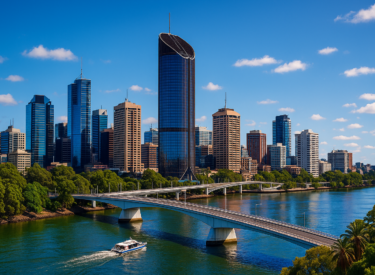
Key takeaways
Historically, property markets slow down before elections as buyers and sellers adopt a "wait and see" approach.
The biggest impact on property markets comes from the policies introduced by the winning government.
After the 2019 election, when negative gearing policies were left unchanged, property prices surged.
The 2022 election had minimal impact on the market as no major property policy shifts were proposed.
Generally, property markets stabilise within 3-6 months post-election.
Elections cause short-term hesitation, but they don’t derail property markets. Smart investors see uncertainty as an opportunity rather than a risk.
With the 2025 Federal Election now locked in for May 3rd, Australian property investors and homebuyers are naturally keen to understand how the electoral outcomes could impact the real estate market.
Historically, elections bring uncertainty, and uncertainty tends to make markets cautious.
Buyers hesitate, sellers hold back, and investors wait to see if major policy changes will affect taxation, lending, or housing affordability.
However, I've found that this temporary slowdown often creates opportunities for savvy investors willing to act amidst the uncertainty.
History shows that while elections may cause short-term disruptions, they rarely change the fundamental forces driving property prices in the long run.
Let's be blunt...the Australian political system, by and large, supports policies that support the value of residential real estate, which is a significant component of national wealth.
No major political party wants to preside over a property downtown that will adversely affect property owners.

Elections create short-term uncertainty, but the market recovers quickly
This election campaigns will last 5 weeks and during that time property market activity is likely to slow down a little.
Buyers and sellers prefer certainty when making big financial decisions, and a change in government can mean potential shifts in housing policies, taxes, and economic settings.
If political uncertainty was a major factor, we’d expect property transactions to drop in the months surrounding an election.
Yet, Domain’s analysis of the past seven federal elections shows no statistically significant impact on property sales:
- Sales before, during, and after an election remain broadly stable.
- In some cases, sales even increase slightly in the lead-up to an election.
- Buyers are primarily influenced by personal factors (job changes, family needs, financial stability) rather than election results
Of course, once the election is over, regardless of who wins, market confidence typically returns within weeks and life goes on.

Note: If you're looking to buy, pre-election jitters can create opportunities to secure a property with less competition.
Overview of Housing Policies by Major Australian Political Parties for the 2025 Federal Election
The housing shortage, affordability and access to somewhere to live for everyone from first-home buyers to renters, are set to be major issues that decide the 2025 federal election on May 3.
Here is a summary of what has been promised so far:
Australian Labor Party
-
Expansion of Support: Boosting the housing support budget to $33 billion, raising income and price caps for the Help to Buy scheme, and excluding HECS debt from mortgage calculations.
-
Supply Initiatives: Implementing the $10 billion Housing Australia Future Fund (HAFF) and the National Housing Accord to facilitate the construction of 1.2 million new homes over five years, including 30,000 social and affordable homes.
Coalition
-
Superannuation for Housing: Allowing homebuyers to use up to 40% of their superannuation for home purchases, with a ceiling of $50,000.
-
Infrastructure and Migration Policies: Investing $5 billion in infrastructure for housing on greenfield sites and reducing overseas migration to decrease competition in the housing market.
The Greens
-
Tax and Rent Policies: Proposing cuts to negative gearing for those with more than two properties and imposing limits on capital gains tax discounts. They advocate for a public property developer to build 360,000 homes in five years and support freezing and capping rent increases.
The key policy areas that could shape the market
While elections create uncertainty, the real concern is not the election itself but the policies the winning government implements.
AMP Chief Economist Shane Oliver reports:
Looking at the Australian residential property market, using CoreLogic data since 1980, capital city property prices have risen 7.7% pa under Coalition governments and 4.3% pa under Labor.
That said, policies with respect to housing have not been particularly different under both sides of politics.
Once in government, political parties are usually forced to adopt at least half sensible policies if they wish to ensure rising living standards and arguably there has been broad consensus in recent decades regarding key macro-economic fundamentals – eg, low inflation and mostly free markets.
Currently both sides of politics are focussed on boosting housing supply.
The Labor Government is focussed on trying to build 1.2 million new homes over 5 years - a target we know cannot be met and its Help to Buy scheme will just boost home prices as more first home buyers compete for the limited number of properties available
The Coalition promises to invest $5 billion in housing infrastructure and cut permanent migration by 25%, however its policy to allow first home buyers to access $50,000 of their super will just boost home prices – great for established home owners.
It is possible that more election promises will occur over the next few weeks so, in my mind, investors should be paying attention to these key areas:
a) Negative Gearing & Capital Gains Tax (CGT)
Negative gearing and CGT discounts have been long-standing features of Australia’s property investment landscape. However, they often become political battlegrounds.
- In the 2019 election, a proposed change to limit negative gearing and reduce CGT discounts led to a sharp decline in investor sentiment. Once it became clear that no changes would be made, confidence rebounded, and house prices surged.
- In the 2022 election, both major parties largely avoided these issues, preventing any major shocks to the market.
If a future government were to restrict negative gearing or reduce CGT discounts, it could lead to a pullback in investor demand, particularly in markets heavily driven by investors, such as Sydney and Melbourne.
However, neither party is suggesting this will happen at present - they want to win this election.
b) Supply and Development Incentives
One of the biggest challenges in Australia’s housing market currently is the lack of supply.
Currently the government is focussing on incentivising private developers to build more homes by offering tax benefits, rezoning land, or fast-tracking approvals.
However, property supply is a long-term issue, and election policies rarely result in an immediate fix.
Note: Policies impacting tax incentives (negative gearing, CGT) tend to affect investors more than affordability measures, which typically benefit first-home buyers.
What history tells us about elections and property markets
Looking at previous Australian elections, a clear pattern emerges:
- Property markets may slow down a little before the election – Buyers and sellers hesitate, listings drop and transaction volumes decline.
- If major property-related policies are proposed, investor sentiment is affected – For example, the 2019 election caused investor anxiety due to proposed negative gearing changes, whereas the 2022 election had minimal impact as no major reforms were on the table.
- Post-election recovery occurs quickly – Regardless of which party wins, property prices typically stabilise and resume their trajectory within three to six months.
For example, in the six months following the 2019 election, Sydney house prices rose significantly as investors re-entered the market after a period of hesitation.
Note: Elections create short-term uncertainty, but they do not override long-term property cycles driven by population growth, supply shortages, and interest rates.

Interest rates and the economy matter more than elections
While election outcomes can shape policy, one of the biggest factor influencing property markets is monetary policy—particularly interest rates.
- If an election coincides with rate cuts, property prices tend to rise, as borrowing becomes cheaper.
- If interest rates remain high, demand can weaken regardless of who is in government.
For example, despite the 2022 election having minimal impact on the market, the RBA’s rapid interest rate hikes in 2022-2023 caused property price declines nationwide.
Note: Elections are a distraction—interest rates, economic growth, and supply-demand dynamics have a bigger impact on property prices.
Final thoughts: what should investors do?
History tells us that while elections create temporary uncertainty, Australia’s property market is resilient and continues to grow over the long term.
So my recommendations are:
- Ignore election noise and focus on long-term fundamentals. Property markets follow bigger economic cycles that go beyond short-term political events.
- Look for pre-election opportunities. If uncertainty causes buyers to hesitate, you may find less competition and better deals in the lead-up to an election.
- Watch for policy shifts post-election. If there are changes to tax laws, lending policies, or housing affordability schemes, adjust your strategy accordingly.
- Pay attention to interest rates and supply trends. These factors will determine property prices far more than who is in power.
In my mind, we should all be stayed informed, but don’t let election fears dictate our decisions.















